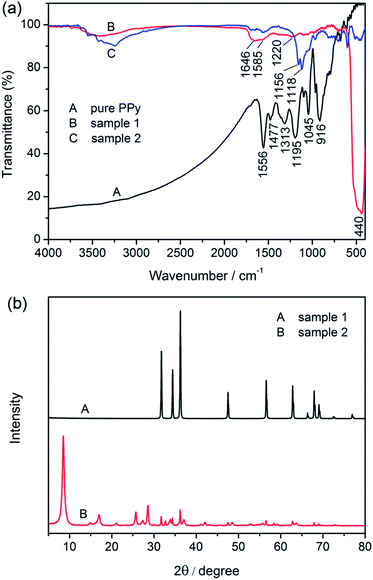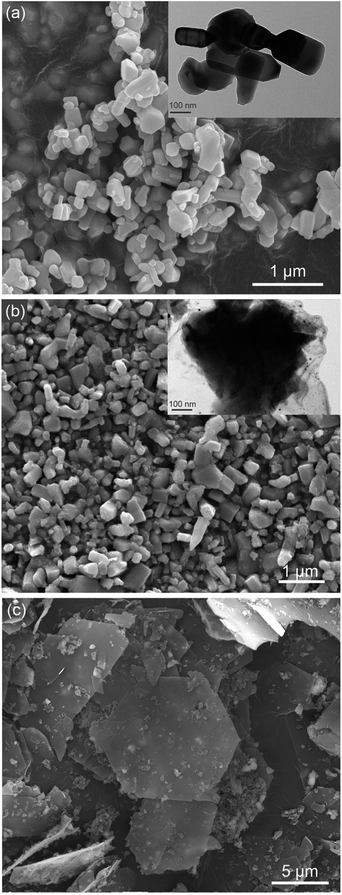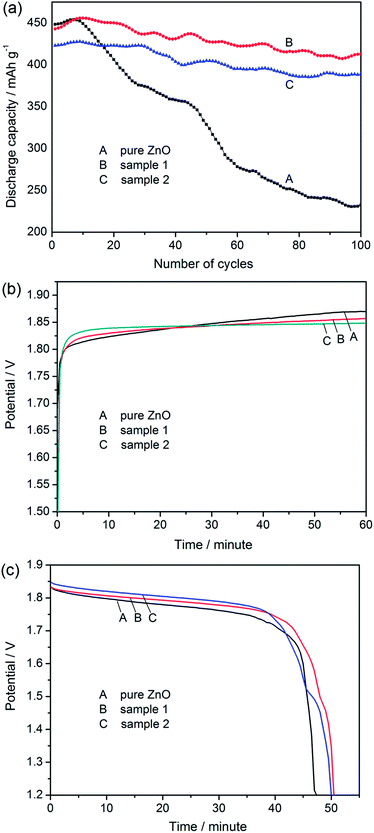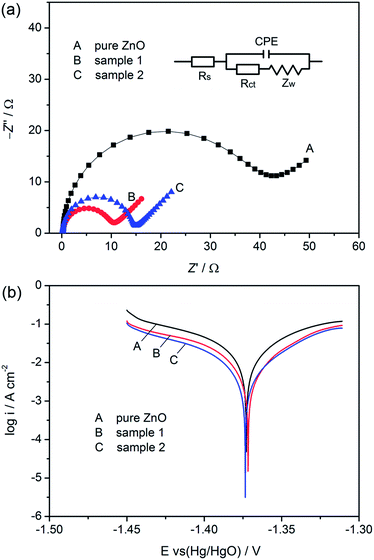Synthesis of ZnO/polypyrrole composites and an application in Zn/Ni rechargeable batteries†
Jianhang Huanga and
Zhanhong Yang*ab
aCollege of Chemistry and Chemical Engineering, Central South University, Changsha 410083, PR China. E-mail: zhongnan320@gmail.com
bKey Laboratory of Resource Chemistry of Nonferrous Metals, Ministry of Education, Central South University, Changsha 410083, PR China
First published on 8th April 2014
Abstract
ZnO/polypyrrole (PPy) composites with different morphology synthesized by a facile ultrasound-assisted chemical polymerization method were used as anode material in order to improve the cycle performance of Zn/Ni rechargeable battery. Granular and layered ZnO/PPy composites were prepared. They provided capacity stability superior to conventional ZnO electrodes during the cycle test.
Due to its abundant reserves, high reduction potential and low electro-chemical equivalent, as well as being environmentally friendly,1–3 zinc is a popular anode material for aqueous primary batteries. However, since its solubility as an active anode material is high, problems arise when it is used as anode material for rechargeable batteries: zincate ions dissolve out during the discharging process and form dendrites, resulting in a low utilization factor and short life cycle.4,5 Various improvements have been made for solving these problems. Among them, metal additives are the most common modified method for zinc electrodes; Bi, Sn, In, Ag, and Ti,5–10 among others, can partially suppress the occurrence and shape of dendrites. On the other hand, Suga et al.11 proposed that anodes comprised of active zinc material and a polymer layer could suppress dendrite growth and shape change. Studies by Vatsalarani et al.12,13 indicated that dip coating, brush coating and electrochemical deposition of polyaniline (PANI) or polypyrrole (PPy) on zinc electrodes was useful in stabilizing electrode capacity.
As a conducting polymer, PPy is a well-known π-conjugated macromolecule. It has attracted great interest owing to high conductivity, redox properties and environment stability, and has applications in numerous field, such as batteries, capacitors, antistatic coatings, and sensors.14,15 The combination of PPy with ZnO to prepare composites that combine the properties of both materials is a very promising approach to extend the application field of PPy but also of ZnO. Some PPy/ZnO functional materials are synthesized by chemical method,16 electro-polymerization17,18 and electro-spun technology.19 In this article, a novel ZnO/PPy composite with different morphology was successfully prepared via a facile ultrasound-assisted chemical polymerization method. Details on the experimental steps of the synthesis, electrode assembly and tests can be found in the ESI.† The as-prepared granular and layered ZnO/PPy composites were coded as sample 1 and sample 2, respectively. The composites were used as active material for Zn/Ni rechargeable cells; studies on the electrochemical and cycling performance of the as-prepared composite are presented. Compared with rapid capacity fading of most applied ZnO5,10 (about 200 mA h g−1 after 100 cycles), the as-prepared ZnO/PPy composites exhibited better capacity retention (about 400 mA h g−1 after 100 cycles).
Fig. 1(a) shows the FT-IR spectra of pure PPy (curve A), sample 1 (curve B), and sample 2 (curve C). For pure PPy, the bands are observed at 1556, 1477, 1313, 1195, 1045 and 916 cm−1. They are close to reported data20,21 for stretching vibration of C![[double bond, length as m-dash]](https://www.rsc.org/images/entities/char_e001.gif) C bond (1556 cm−1), C–C bond (1313 cm−1), and bonds of the pyrrole ring (1477, 1195, 1045, 916 cm−1). For sample 1, the strongest absorption band at 440 cm−1 is assigned to the Zn–O bond due to high content of the ZnO particle. Although the intensity of absorption bands of sample 1 between 500 and 1600 cm−1 is low, conjugated double bond at 1646, 1585 and 1220 cm−1, which show a broadening and a shift towards high wavenumber compared with pure PPy could indicate the existence of PPy. For sample 2, the band corresponding to Zn–O bond almost disappears while two new strong absorption bands at 1156 and 1118 cm−1 arise, suggesting that there is a strong chemical interaction between PPy and ZnO to form a new complex. The reason for strong chemical reaction may be attributed to the ultrasound during the synthesis process. The mechanical effects of ultrasound (intense turbulence associated with shear and liquid circulation) not only provide improved particle distribution, but also a faster initiator dissociation that generates an enhanced quantum of radicals during the polymerization process and thus gives a strong chemical reaction with ZnO.17 The bands at 1156 and 1118 cm−1 are assigned to the coordination bond between zinc and nitrogen.
C bond (1556 cm−1), C–C bond (1313 cm−1), and bonds of the pyrrole ring (1477, 1195, 1045, 916 cm−1). For sample 1, the strongest absorption band at 440 cm−1 is assigned to the Zn–O bond due to high content of the ZnO particle. Although the intensity of absorption bands of sample 1 between 500 and 1600 cm−1 is low, conjugated double bond at 1646, 1585 and 1220 cm−1, which show a broadening and a shift towards high wavenumber compared with pure PPy could indicate the existence of PPy. For sample 2, the band corresponding to Zn–O bond almost disappears while two new strong absorption bands at 1156 and 1118 cm−1 arise, suggesting that there is a strong chemical interaction between PPy and ZnO to form a new complex. The reason for strong chemical reaction may be attributed to the ultrasound during the synthesis process. The mechanical effects of ultrasound (intense turbulence associated with shear and liquid circulation) not only provide improved particle distribution, but also a faster initiator dissociation that generates an enhanced quantum of radicals during the polymerization process and thus gives a strong chemical reaction with ZnO.17 The bands at 1156 and 1118 cm−1 are assigned to the coordination bond between zinc and nitrogen.
 | ||
| Fig. 1 (a) FT-IR spectra of pure PPy (curve A), sample 1 (curve B) and sample 2 (curve C); (b) XRD pattern of sample 1 (curve A) and sample 2 (curve B). | ||
Fig. 1(b) shows the XRD pattern of the sample 1 (curve A) and sample 2 (curve B). For sample 1, all the peaks match well with the standard ZnO of the hexagonal wurtzite structure (JCPDS card 36-1451), which implies that a small amount of PPy has no obvious effect on the crystal structure of ZnO. In other words, the PPy may just cover the surface of the ZnO particle, and there is no new crystal structure formed. For sample 2, the diffraction peaks of ZnO were subjected to a radical shrink, and four diffraction peaks arise at 8.5°, 17°, 26°, and 28.5°, respectively. In sample 2, a new crystal structure formed with the increasing pyrrole monomer, which is consistent with the result of FT-IR spectra. The new structure implies that there is a novel zinc coordination complex formed with the polypyrrole ligand, which is no longer a hybrid composite. For convenience, samples 1 and sample 2 are collectively called the “ZnO/polypyrrole composite” in the article title and abstract.
Fig. 2 show the morphology images of pure ZnO(a), sample 1(b), sample 2(c). As shown in Fig. 2(a) and (b), the appearance of pure ZnO and sample 1 are similar, so we provide the low-dissolution TEM images of pure ZnO (inset of Fig. 2(a)) and sample 1 (inset of Fig. 2(b)). Compared with the clean, smooth edge of ZnO, the particles with dark color in the inset of Fig. 2(b) should be ZnO particles, and the corrugations around the oxide core should be the polypyrrole. The ZnO particle is coated with a layer of PPy film, this result is consistent with the assumption from FT-IR and XRD result.
 | ||
| Fig. 2 (a) SEM images of pure ZnO particles (inset: TEM images of pure ZnO particles); (b) SEM images of sample 1 (inset: TEM images of sample 1); (c) SEM images of sample 2. | ||
From Fig. 2(c), it can be seen that the sample 2 has hexagonal layer morphology although some plates are incomplete. This morphology is entirely different with ZnO particles, combining the results from FT-IR and XRD analysis, it is sure that ZnO formed a new crystal structure with PPy. In addition, there are some small particles distributed on the surface of layer, it could be the excessive ZnO particles.
Fig. 3(a) illustrates the electrochemical cyclic behaviors of the pure ZnO electrode (curve A), sample 1 electrode (curve B) and sample 2 electrode (curve C). Despite its high discharge capacity in the first several cycles, the pure ZnO electrode suffered from rapid capacity fade. At 100 cycles, discharge capacity decreased to 232 mA h g−1 with a retention of 50.9%. In comparison to pure ZnO, the stability of as-prepared samples is remarkably superior. After 100 cycles, the discharge capacity of sample 1 and 2 electrodes decreased to 413 and 388 mA h g−1 with a retention of 90.5% and 90.8%, respectively. Note that the capacity of sample 2 electrode is about 30 mA h g−1 lower than that of sample 2. This phenomenon is associated with the initial amount of pyrrole, which decreases the percentage of ZnO in the electrode, as well as the new crystal structure nature of sample 2.
The essential reason for the short lifetime of the Zn electrode is the dissolution of ZnO in the alkaline electrolyte. Hence, any approach to improving its lifetime should be directed at retaining oxidized species at the electrode. From the above results, the as-prepared samples are effective in retaining the oxidized species at the electrode. This could be ascribed to the existence of PPy. For sample 1, PPy film around the ZnO particles restricts the diffusion of oxidation products into the electrolyte.12 For sample 2, there is a new complex formed. The zinc–nitrogen coordination interactions of the complex occurring during the polymerization process could make the zinc under control in the complex rather than dissolving to the electrolyte, and then limiting the diffusion of oxidation products away from zinc electrode. Fig. 3(b) and (c) show the typical charge, discharge curve of pure ZnO electrode (curve A), sample 1 electrode (curve B), and sample 2 electrode (curve C) at the 10th cycle. The obvious difference between the charge curves of pure ZnO and as-prepared samples is that the former's plateau voltage rises faster in comparison with the latter's stability. The discharge plateau voltage of as-prepared samples is higher than that of pure ZnO. These phenomena bear the advantages of the ZnO/PPy composite's good reversibility.
For the bare ZnO electrode, dissolution of oxidation product in the discharge process leads to the nonuniform electrodeposition of Zn in the charge process, which causes growth of zinc dendrites, resulting in increased electrochemical polarization of the electrode. The increasing polarization in turn accelerates dissolution of ZnO in the discharge process, leading to a vicious circle. But in the as-prepared samples, the existence of PPy effectively suppresses the dissolution of the oxidation product, and also makes the electrodeposition uniform due to the re-complexation of zincate ions with PPy imine bonds. These factors eliminate the vicious circle mentioned above, thereby suppressing electrochemical polarization. This is why the as-prepared samples possess more stable charge plateau voltage and higher discharge plateau voltage compared to the pure ZnO electrode.
Fig. 4(a) presents Nyquist plots of the pure ZnO electrode (curve A), sample 1 electrode (curve B) and sample 2 electrode (curve C). The Nyquist plots show a semi-circle arc in the higher frequency region and a straight line in the lower frequency region. These features are associated with the double-layer capacitance (CPE) in parallel with the charge transfer resistance (Rct) and Warburg impedance (Zw), which are characteristic of semi-infinite diffusion, respectively. According to the Randles–Ershler type equivalent circuit22 in Fig. 4(a), we can get the Rct of the pure ZnO, sample 1 and sample 2 electrodes (37.4 Ω, 9.3 Ω and 13.9 Ω, respectively) and the Zw (0.032 Ω, 0.43 Ω and 0.62 Ω, respectively). Note that the Rct of samples 1 and 2 are lower than those of the pure ZnO electrode, but the Warburg resistance of the two samples is higher than that of the pure electrode. The lower charge-transfer resistance is associated with electron mobility enhancement owing to the highly extended chain conformation of PPy, which is also attributed to the conjunction and synergistic effect of PPy and zinc.12,23 But the higher Warburg resistance means that the ion diffusion of the electrode is slowed by PPy. Taken together, PPy is ultimately more beneficial than detrimental to the electrochemical performance of the electrode.
Fig. 4(b) shows Tafel curves of the pure ZnO electrode (curve A), sample 1 electrode (curve B) and sample 2 electrode (curve C). It can be observed that there is almost no movement on the corrosion potential (Ecorr), which is around −1.372 V, but the corrosion current density (icorr) has markedly shifted in a negative direction for the as-prepared samples, which are obtained by extrapolation of the anodic and cathodic Tafel lines: icorr is 25.4, 15.5 and 12.6 mA cm−2, respectively, for the pure ZnO, and samples 1 and 2 electrodes. The lower value of icorr is due to the stability of ZnO/PPy composites and the decline in anode dissolution. PPy corrugation around ZnO in sample 1 and layered structure in sample 2 can retain the oxidation product at the electrode rather than dissolving into electrolyte, and thus prevent further corrosion of the electrode.
Conclusions
The ZnO/PPy composite (sample 1) and Zinc/PPy complex (sample 2) with layered morphology were successfully synthesized. The TEM image of sample 1 shows PPy corrugation around the ZnO particles. Sample 2 presents a new layer morphology. The as-prepared samples as anode material for Zn/Ni rechargeable cells show better electrochemical cycle stability, more stable charge plateau voltage and higher discharge plateau voltage compared to the conventional ZnO. Improved results from zinc–nitrogen coordination interactions in the ZnO/PPy electrode are also attributed to the conjunction and synergistic effects of PPy and zinc. The latter retain oxidization products and make deposition of zincate ions uniform on the surface of electrode, suppress the growth of zinc dendrite and decrease the charge-transfer resistance, leading to a low electrochemical polarization.Acknowledgements
We are grateful for financial support from the Natural Science Foundation of China (no. 21371180 and 91023031), Doctoral Fund of the Ministry of Education of China (20130162110 018) and the Science and Technology Project of Changsha city (no. k1303015-11 and k1203014-11).Notes and references
- R. F. McLarnon and J. E. Crains, J. Electrochem. Soc., 1991, 138, 645 CrossRef PubMed.
- Y. F. Yuan, J. P. Tu, H. M. Wu, B. Zhang, X. H. Huang and X. B. Zhao, Electrochem. Commun., 2006, 165, 653 CrossRef PubMed.
- J. Jindra, J. Power Sources, 1997, 66, 15 CrossRef CAS.
- B. Yang and Z. H. Yang, RSC Adv., 2013, 3, 12589 RSC.
- S. H. Lee, C. W. Yi and K. Kim, J. Phys. Chem. C, 2011, 115, 2572 CAS.
- D. Q. Zeng, Z. H. Yang, S. W. Wang, X. Ni, D. J. Ai and Q. Q. Zhang, Electrochim. Acta, 2011, 56, 4075 CrossRef CAS PubMed.
- J. Z. Wu, J. P. Tu, Y. F. Yuan, M. Ma, X. L. Wang, L. Zhang, R. L. Li and J. Zhang, J. Alloys Compd., 2009, 479, 624 CrossRef CAS PubMed.
- Z. G. Luo, S. B. Sang, Q. M. Wu and S. Y. Liu, ECS Electrochem. Lett., 2013, 2, A21 CrossRef CAS PubMed.
- J. Jindra, J. Power Sources, 2000, 88, 202 CrossRef CAS.
- Y. F. Yuan, Y. Li, S. Tao, F. C. Ye, J. L. Yang, S. Y. Guo and J. P. Tu, Electrochim. Acta, 2009, 54, 6617 CrossRef CAS PubMed.
- M. Suga, S. Akita and N. Kuroda, US Pat. 5,382,482, 1995.
- J. Vatsalarani, S. Geetha, D. C. Trivedi and P. C. Warrier, J. Power Sources, 2006, 158, 1484 CrossRef CAS PubMed.
- J. Vatsalarani, D. C. Trivedi, K. Ragavendran and P. C. Warrier, J. Electrochem. Soc., 2005, 152, A1974 CrossRef CAS PubMed.
- A. Malinauskas, Polymer, 2001, 42, 3957 CrossRef CAS.
- H. M. Xiao, W. D. Zhang, M. X. Wan and S. Y. Fu, J. Polym. Sci., Part A: Polym. Chem., 2009, 47, 4446 CrossRef CAS.
- S. S. Barkade, D. V. Pinjari, A. K. Singh, P. R. Gogate, J. B. Naik, S. H. Sonawane, M. Ashokkumar and A. B. Pandit, Ind. Eng. Chem. Res., 2013, 52, 7704 CrossRef CAS.
- A. B. Moghaddam, T. Nazari, J. Badraghi and M. Kazemzad, Int. J. Electrochem. Sci., 2009, 4, 247 CAS.
- M. Dhingra, S. Shrivastava, P. S. Kumar and S. Annapoorni, J. Electron. Mater., 2013, 42, 6 CrossRef PubMed.
- E. F. de Melo, K. G. B. Alves, S. A. Junior and C. P. de Melo, J. Mater. Sci., 2013, 48, 3652 CrossRef CAS PubMed.
- L. Geng, Y. Zhao, X. Huang, S. Wang, S. Zhang, W. Huang and S. Wu, Synth. Met., 2006, 156, 1078 CrossRef CAS PubMed.
- H. C. Kand and K. E. Geckeler, Polymer, 2000, 41, 6931 CrossRef.
- B. Huang, F. Li, Q. C. Yu, G. Chen, B. Y. Zhao and K. A. Hu, J. Power Sources, 2004, 128, 135 CrossRef CAS PubMed.
- A. Batool, F. Kanwal, M. Imran, T. Jamil and S. A. Siddiqi, Synth. Met., 2012, 161, 2753 CrossRef PubMed.
Footnote |
| † Electronic supplementary information (ESI) available: Details on the experimental steps of the synthesis, electrode assembly and tests. See DOI: 10.1039/c4ra01322k |
| This journal is © The Royal Society of Chemistry 2014 |


